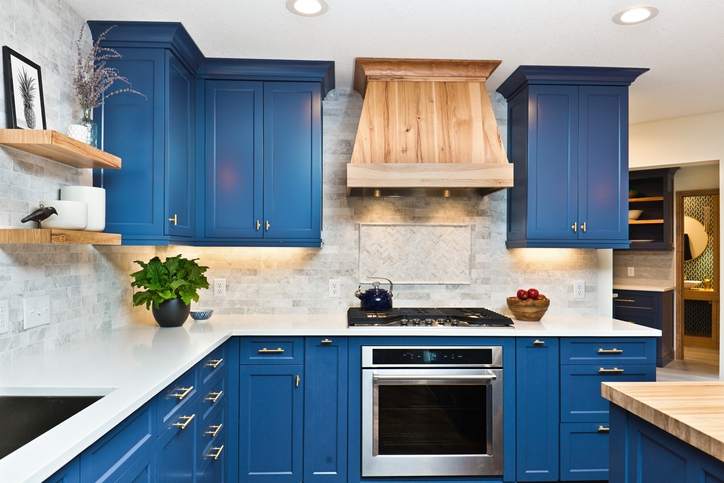Owning a home provides you with more than just a roof over your head. It’s a major financial asset that usually increases in value over time. Your home’s value affects how much equity you have, which can be borrowed. This can come in handy when you need cash for major expenses such as home improvements or medical bills, or to consolidate high-interest debts and save money in the long run.
A cash-out refinance is one of the most practical and affordable ways that qualified homeowners can borrow their equity to afford large expenses. Here’s what you need to know about cash-out refinancing.
Key Takeaways:
- A cash-out refinance works by replacing your existing mortgage with a new, larger one, and the difference between the loans can be borrowed in cash.
- While there are no restrictions on what a cash-out refinance can be used for, it’s recommended to use it for financially savvy purposes, such as consolidating high-interest debts.
- Some things to consider before getting a cash-out refinance are that the terms of your mortgage will change, and that you’ll have to pay closing costs.
What Is a Cash-Out Refinance?
A cash-out refinance is one of the most common ways homeowners borrow their equity, which is the difference between the value of your home and what you owe on it. Cash-out refinances work by taking out a new mortgage based on the market value of your home. The new loan is used to pay off your old mortgage principal, and the extra cash is yours to spend as you please.
For example, let’s say you owe $180,000 on your mortgage and your home is worth $250,000. You could do a cash-out refinance by taking a new loan for $200,000, repaying the $180,000 owed on your current loan, and keeping the $20,000 difference.
The trade-off is that you have a new, larger mortgage, and your monthly payment likely will be more. It also means you start over your loan term — typically 15 or 30 years — and it will take longer for you to pay off the loan in full.
That trade can be worth making if you use the extra cash to retire high-interest debts, such as credit cards, that eat up your monthly budget. It also may make sense to put the funds toward a financially worthwhile purpose, such as a renovation that increases the value of your home, or a college education that helps you or your children earn more money.
Types of cash-out refinancing
Getting approved for a cash-out refi — and figuring out how much you can take out — depends on a few factors. A big one is the type of mortgage you have. For example, USDA loans can’t be used for a cash-out refinance.
Here’s a breakdown of the types of mortgages that are eligible for a cash-out refinance and their requirements:
Mortgages Eligible for a Cash-Out Refinance
| Type of Mortgage | Minimum Equity You Need To Refinance | Credit Score Minimum | Other Requirements | How Much Cash You Can Take Out |
| Conforming conventional loan | 20%. | 620. | Must own the home for at least six months. | No more than 80% of your home’s value. |
| Federal Housing Administration loan | 20%. | 500, though a score of 580 or better will help you qualify for better terms and rates. | — Must own the home and live in it as your primary residence for at least a year. — Must show you’ve made payments on time over the past 12 months. | Typically, 80% of your home’s value, although some lenders may allow for 95%. |
| Veterans Affairs loan | 10%. | No official minimum, but lenders can set their own requirements. | — Must qualify for a VA-backed certificate of eligibility. — Must live in the home you’re using a VA loan refinance for. — Must pay a VA funding fee, which is either 2.3% or 3.6% of the loan amount. | 100% of your home’s value, or up to the conforming loan limits set by Fannie Mae and Freddie Mac. |
| Nonconforming conventional or jumbo loan | Varies by lender. | Varies by lender, but it’s generally recommended to have a score of 680 for 30-year jumbo loans, and 740 for 15-year jumbo loans. | Lenders will set their own requirements to refinance a jumbo loan, which can be extensive. | No more than 80% of your home’s value, though some lenders set lower limits. |
Keep in mind that individual lenders may have their own requirements as well.
How Does a Cash-Out Refinance Work?
Cash-out refinancing uses the money borrowed with a new mortgage to pay off your existing one, essentially replacing your previous home loan. The difference between the new mortgage and the old mortgage is the amount you get in cash. The interest rate, monthly payment, and loan terms may be different with the new mortgage.
“The interest rate depends on the borrower’s credit, the value of the house, the type of mortgage, and more,” says Kevin Leibowitz, founder and CEO of Grayton Mortgage, a brokerage with offices in Brooklyn, New York; and Cary, North Carolina.
Typically, cash-out refinance rates are slightly higher than interest rates for regular mortgages because you’re increasing the loan size and decreasing your equity. You can use a refinance calculator to see how much your loan would cost based on the rate offered.
What is home equity?
Home equity is the difference between the value of your home and what you owe on your mortgage. The larger the gap between your home value and loan amount, the more equity you have.
As a homeowner, it’s good to see your home equity grow over time because it increases your overall net worth. Home equity can increase in two ways:
- By paying down your mortgage, which reduces the amount you owe relative to your home’s value.
- By increasing your home’s value, which usually happens naturally over time due to market factors such as inflation, supply and demand, etc. However, there are ways to help increase your property’s value with home improvements.
How do you calculate home equity?
The formula for calculating home equity is fairly simple. Add up the balance on all mortgages that use the home as collateral, and subtract that total from your home’s market value.
The tricky part is figuring out what your home is worth. You can estimate, but a lender will require a refinance appraisal to determine that amount.
How much cash can you get from refinancing?
Even if you’ve built a lot of equity in your home, you usually can’t borrow the entire amount.
“The type of mortgage (conventional, FHA, VA) will dictate what percentage of the equity can be taken out,” says James Polinori, chief marketing officer at Geneva Financial, a mortgage lender based in Chandler, Arizona.
Though there are other factors that affect how much equity you can borrow, a good rule of thumb is that a homeowner can cash out up to 80% of their home’s value, Polinori says.
What are closing costs on a cash-out refinance?
Just like there are closing costs when you buy a home, cash-out refinancing comes with closing costs as well. These are fees that cover the administrative costs behind the loan and other third-party services, and are due when a loan closes.
Closing costs on a refinance are about $5,000 on average, though there are ways to reduce your refinance closing costs.
Common closing costs on a refinance include:
- Origination fees.
- Home appraisal fees.
- Home inspection fees.
- Attorney fees.
- Title search fees.
- Credit report fees.
- Recording fees.
- Survey fees.
“This is something that should not be overlooked when factoring in whether a cash-out refinance makes sense in the long run,” Polinori says.
How are your taxes affected by a cash-out refinance?
Among the tax benefits of owning a home, a cash-out mortgage refinance is considered a loan instead of income. That means you don’t have to pay income taxes on what you borrow.
Cash-out refinancing has other benefits and tax implications. If you use the funds to make permanent home improvements that increase your property’s value, you can deduct the original loan interest. And if you purchased mortgage points to lower the interest rate on your cash-out refinance, you also can deduct those costs.
Cash-out refinancing example
Say you buy a home for $500,000. You make a 10% down payment, which totals $50,000, and finance the remaining $450,000 using a 30-year fixed-rate mortgage with a 7% interest rate.
After roughly six years, you will have paid the balance down to about $417,112. During that time, if the home’s value appreciates at around 3% per year, its value will have increased to about $597,000, so you’ll have just under $180,000 in equity. At the same time, you’ve racked up about $20,000 in credit card debt at an annual percentage rate of 15%, and you’re thinking about getting a cash-out refinance to consolidate this high-interest debt.
Refinancing 80% of your home’s value would give you a new $477,600 mortgage. Factor in $5,000 of closing costs, and that’s enough to pay off the previous $417,112 loan and have $55,488 left over. You can use that extra cash to pay off your credit card debt and still have some funds left for something else, such as a home improvement project.
Consolidating your debts means you would no longer make separate credit card and mortgage payments. Repaying your original credit card debt at the lower interest rate on your new mortgage also means the total of your monthly debt payments would shrink. On the downside, your mortgage payment likely would increase; you would be restarting your loan term, which keeps you in debt longer; and you would have to pay closing costs on the refinance.
What You Can Do With a Cash-Out Refinance
The money you take out can be used for anything you want. But since you have to pay it back, it’s best to use it wisely.
“I always encourage my borrowers to use it for sensible items,” Leibowitz says. “Buying a car or taking a vacation and paying it off for 30 years is not a good idea.”
Below are common reasons homeowners get a cash-out refinance.
Fund home improvement projects
One of the more popular reasons to take a cash-out refinance is to borrow money for home improvements. Cash-out refinancing can give you the money needed to make renovations that boost the value of your home right away, without relying on high-interest credit cards or short-term personal loans, or burning through your savings.
Consolidate high-interest debts
Credit cards or loans with high interest rates can eat up a lot of your monthly income. Cash-out refinancing allows you to consolidate debts into your mortgage and pay it off at a lower rate over a longer period. Paying off those debts also means no more monthly payments, which frees up cash each month for other expenses.
“By paying off higher-interest accounts, you will pay much less in interest over time,” Polinori says. “This may improve your overall credit.”
Pay for college tuition and expenses
Whether you’re paying for your own degree or putting a child through college, cash-out refinancing can be a good alternative to student loans. That’s especially true if you need to take out private student loans, which usually cost more than federal student loans.
Use funds to invest
Some homeowners may want to use the funds from a cash-out refinance to invest, whether that be in the stock market or real estate. This can be a risky option because the market is volatile, and you could easily see your investments decrease in value.
However, if mortgage rates are low, you may decide it’s worth the risk. Historically, the stock market has offered annual returns of 10%. If you can get a low-cost mortgage, such as one with an interest rate of 5%, you could come out ahead by cashing out your equity and investing.
How To Get a Cash-Out Refinance
If you’re thinking about getting a cash-out refinance, there are a few steps to take.
Make sure you can afford the loan
Cash-out refinancing will increase the balance on your mortgage, which usually means your monthly payment will increase. Do the math and look over your budget to make sure you can afford a larger payment before you pursue a cash-out refinance.
One way to make sure you can afford a cash-out refinance is to compare your income to the new loan’s payment. A common rule of thumb for lenders is that you shouldn’t spend more than 28% of your gross monthly income on a mortgage.
Gather necessary documents
When getting ready to apply, it’s important to gather as much information as possible ahead of time. The list of documents needed for refinancing is extensive, so getting organized will help save time.
Expect to show:
- Pay stubs from the past two or three months.
- W-2s or 1099s from the last two years.
- Your most recent tax return.
- Bank statements.
- Brokerage statements.
- Credit card and loan statements.
With detailed record-keeping, your lender will get an accurate picture of your finances and move the application process along swiftly.
Know the requirements for a cash-out refinance
Knowing ahead of time the general requirements for a cash-out refinance will help you prepare for the application process, and may improve your chances of getting approved. Requirements vary, but in general, lenders set the following minimum requirements:
- Credit score. The minimum score required for a cash-out refinance varies by loan type and lender, but generally the minimum is 620.
- Debt-to-income ratio. Your DTI ratio measures how much of your monthly income goes to paying debts. The maximum DTI ratio allowed is 50% for conventional loans, but lenders may require a lower ratio to approve your application. Use our DTI ratio calculator to get started.
- Equity in your home. Cash-out refinancing is possible only if you have equity, and it typically must be at least 20% of your home’s value. Your home likely needs to be appraised to determine its current market value.
- Seasoning requirement. In most cases, you’ll need to have owned your home for a while before refinancing. This is known as the “seasoning requirement.” For most mortgages, it’s six months. There are a few exceptions, such as when you inherit a property, or if it was legally awarded to you — in a divorce settlement, for instance. FHA loans have a longer seasoning requirement of 12 months.
Decide how much cash you need
With a cash-out refinance, it’s a good idea to take out only as much as you need. If you’re planning home improvements, itemize the work you plan to do and estimate how much it will cost. If you’re consolidating debt, add up your balances to find out how much you need to pay them off. Even if you’re allowed to borrow more, it’s important to minimize the cash you’re taking out because you’ll be paying interest on those funds for the life of your new loan.
It’s also important to keep some equity in your home. Most lenders refuse to cash out 100% of your equity. For conventional loans on single-unit homes, lenders generally allow you to borrow up to 80% of the property’s value. Some FHA loans will let you borrow up to 85% or 95%. The exception is VA loans, which allow for 100% financing, and even then, the individual lender might not allow it.
Get approved by your lender
After you’ve compared several quotes and decided on a lender, you’re ready to apply.
The underwriting process can take a few days to a few weeks. It’s important to respond as soon as possible to any communications from your lender to avoid delays.
Also, avoid borrowing money, moving large sums of cash around, or applying for new lines of credit until your loan has been approved, as this can lead to delays or to your loan being denied.
What To Consider Before Getting a Cash-Out Refinance
Before you go through with cash-out refinancing, there are some finer points to consider.
- The terms of your mortgage will change. You’re taking on a new loan, which means a new loan term, interest rate, and other features. If you don’t do your due diligence, you could end up with a less favorable mortgage.
- You’ll pay closing costs. These costs will likely be thousands of dollars and will add to the cost of your new loan.
- You’ll need a new appraisal. The lender will want to make sure your home is worth enough to secure the new loan. If real estate values have fallen in your area or your home is in poor shape, you might not be able to cash out as much as expected.
- It will take time to get your money. Closing on a loan can take weeks or months, so don’t make plans to use cash-out refinancing to get quick cash.
- You can’t borrow all your equity. Most lenders will limit you to borrowing 80% of your home’s value.
- You’ll need 20% equity or more to refinance. If you recently moved in, you may not be able to get a cash-out refinance, or it may not be worth doing.
- You may have to meet occupancy requirements. Depending on the terms set by your lender, you may have to use the home as your primary residence for a set period after refinancing. This applies to cash-out refinances on FHA loans and VA loans.
- The interest may be tax deductible. This may make you more comfortable with increasing your mortgage balance from a refinance.
- It’s unwise to use the cash for a spending spree. Getting a large sum of cash can lead to the temptation to overspend. If you spend your equity on something that doesn’t advance your financial situation, it can leave you worse off than before, and it will take years to pay it off.
Pros and Cons of Cash-Out Refinancing
Taking equity out of your home can give you cash to consolidate debt or handle other key expenses, but it does mean taking on more debt overall. It’s important to consider the advantages and disadvantages before you go through with it.
Advantages of cash-out refinancing
When done right, there are many benefits to cash-out refinancing, including:
- You can score a lower interest rate on your mortgage. If your credit has improved since you took out your original mortgage, or interest rates have dropped, you can simultaneously tap into your equity and refinance at a lower interest rate.
- Renovating or repairing your home may add value. You can use the cash to make certain upgrades to your home, like remodeling the kitchen or a bathroom, which could boost your home’s value.
- You can simplify debts and improve your credit. Consolidating your debts with a cash-out refinance can help you save money, and reduce the number of payments and due dates you have to keep track of each month. This also can help boost your credit score by lowering your credit utilization ratio.
- Refinancing can help cover education costs. If you don’t want to take on the higher interest rates attached to private student loans, a cash-out refinance can be a cheaper way to pay for an education.
- More affordable than other loans. Using a cash-out refinance to pay for home improvements or student loan costs can be less expensive than using a personal loan.
Disadvantages of cash-out refinancing
Cash-out refinancing isn’t right for all situations. Here are a few instances when homeowners might want to consider a different option:
- Your existing mortgage rate may increase. Refinancing doesn’t always result in a lower interest rate, especially since rates for cash-out refinances tend to be higher.
- Your repayment term may be extended. If you refinance to a mortgage with the same term as your previous loan, you’ll restart the clock and be paying for your home over a longer period — thus spending more on interest. Requesting a custom term could help you avoid that scenario, but choosing a shorter term will increase your monthly payment.
- You risk losing your home if you can’t repay the loan. Since your home is collateral for the refinance, failing to make your mortgage payments means you could lose your home to foreclosure.
- You lose equity in your home. Cash-out refinancing turns equity into money. It will take a while to build back that equity.
- It costs money to refinance. Expect to pay about $5,000 to refinance your mortgage, which can eat into the cash you’ll take out of the home.
Alternatives to Cash-Out Refinancing
A cash-out refinance isn’t the only way to access funds. In fact, there are other options you can use to borrow against your home’s equity.
Here are a few alternatives to cash-out refinancing.
Home equity line of credit
A home equity line of credit, or HELOC, is a type of revolving debt. Your property serves as collateral for the HELOC, and you can borrow against the home’s equity as needed. HELOCs often work like a credit card.
HELOCs may come with a draw period that lasts a fixed amount of time, during which you can borrow against your line of credit. Once the draw period is over, you can no longer borrow money and must renew your credit line or begin to repay the outstanding balance.
Home equity loan
A home equity loan allows you to tap your home’s equity by borrowing a lump sum that you repay in fixed, monthly payments in addition to your mortgage. Your property serves as collateral for your home equity loan, so it’s important to make payments on time and avoid defaulting.
Reverse mortgage
Reverse mortgages are available to homeowners ages 62 and over with eligible homes. They allow older people to borrow against the equity in their homes as long as they live there. Rather than making a monthly mortgage payment and reducing the balance owed, the homeowner receives a payment from the lender and the balance owed increases.
A reverse mortgage typically doesn’t have to be repaid until the borrower dies or moves out of the home. Often, the loan is repaid by selling the home. The longer a reverse mortgage is in effect, the more equity is used up by the time the loan is due for repayment.
The lender typically charges closing costs, reverse mortgage insurance, and other fees. The interest on the loan grows as the borrower continues to receive payments from the reverse mortgage.
Reverse mortgages are complicated products with risks and responsibilities that should be fully understood before taking out this type of loan.
Personal loan
A personal loan is an unsecured loan paid back with interest over a certain time frame. Because not having collateral is riskier for the lender, interest rates on unsecured loans tend to be higher.
How much you can borrow will be based on your financial situation, with the typical range between $5,000 and $45,000. The loan usually has a fixed interest rate and a repayment term of two to five years.
Some personal loans are secured, meaning they are backed by collateral, and may come with a lower interest rate.
Standard refinance
If you don’t need to take equity out of your home and just want to change your loan’s terms, look to a standard refinance. With a standard refinance, you simply apply for a new mortgage, and use the funds to pay off the old one. This lets you change things like your lender or your loan type.
Rate-and-term refinance
A rate-and-term refinance, like a standard refinance, does not involve taking equity out of your home. Its goal is to let you change the interest rate and loan term of your mortgage.
For example, if you have 20 years left on a mortgage at a 7% interest rate, you might consider a rate-and-term refinance to get a 15-year mortgage at 6% interest. Your payment may increase slightly, but you’ll pay the loan off sooner and save money overall.
You also could extend the term of your loan to lower your monthly payment, though that may increase the total amount of interest you’ll pay.
Is a Cash-Out Refinance Right for You?
A cash-out refinance can be a good idea for homeowners who need cash and have equity in their homes. Mortgage debt is relatively inexpensive compared to credit cards or other types of loans. The key is to use it wisely.
For instance, if you have high-interest debts to pay off or are pursuing a degree that can result in higher earnings, a cash-out refinance may be a cost-effective way to achieve those goals.
On the other hand, if you’re interested in making a purchase that won’t lead to a higher net worth over time, such as a car or family vacation, you’re probably better off saving up some money or relying on unsecured financing that won’t put your home at risk if you fall behind on payments.
Cash-Out Refinancing FAQ
Below are the answers to some common questions about cash-out refinancing.
How long does it take to refinance? Once you apply for a cash-out refinance, it can take anywhere from 30 to 45 days for the loan to close.
Any time you borrow money, there’s an effect on your credit. When you apply for a cash-out refinance, the lender performs a hard inquiry, which can temporarily lower your credit score by a few points. Taking out a new loan also means your total debt will increase, which can decrease your credit score.
Repaying the loan on time will improve your credit. And having a loan of this type in good standing diversifies your credit mix, which also is positive.
Cash-out refinancing is not something you do on a whim, because it takes time and puts your home at risk if you can’t afford the payments. That said, it can be a good idea if you use the money to improve your financial situation. For example, if you make improvements to your home that ultimately increase its value, or pay off high-interest credit card debt, cash-out refinancing can be worth it.
The Bottom Line on Cash-Out Refinancing
Cash-out refinancing can be a less expensive way to borrow a lot of money. If used the right way, it can help increase your net worth over time. Whether you want to upgrade your home, consolidate debts, or pay for college, tapping into your home’s equity can be a smart move.
But remember, there’s a lot at stake: Your home serves as collateral, so it’s crucial that you keep up with the payments. As with any major financial decision, it’s important to crunch the numbers and weigh the pros and cons before making a final choice.
T.J. Porter contributed to the reporting for this article.






